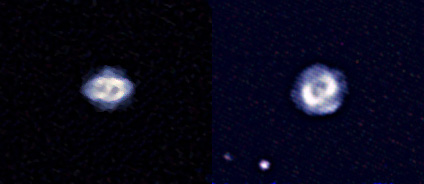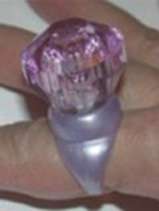The Eyeball And The Snowball

What I like most about imaging planetary nebula is that they are strange. They have very odd shapes which are individually unique and often resemble things we are familiar with. The nebula on the right is NGC 7662, better known as the Snowball Nebula. See my writeup about this nebula at: The Snowball Nebula
The nebula on the left is NGC 7009 or the Saturn Nebula named so because it resembles the rings of Saturn seen almost edge on. It's about 1400 light years distant from us. Frankly, I think it looks more like an eyeball or the CBS tv logo. I took the Saturn Nebula image on 7/16/04 at 2:11am est with my 8" SCT and a Vesta Pro webcam.
Another strange thing about these kind of nebula is that you are basically looking back with a kind of photon time machine (the telescope) at a star that eons ago has stopped working and gone into its late retirement years. It has gone from being a massive red giant blowing off a shell of gas light years across to become a small hot white dwarf with in some cases a diameter no bigger than the planet Earth. You can see the white dwarf star in the center of both images.
Another unusual thing is that we don't really understand these objects very well. Astronomers are still puzzeld as to how planetary nebula acquire these unique shapes and strange symmetries. The computerized models we have suggest that we should be seeing a lot of gas turbulence withing the nebula itself which we aren't seeing at all. We do see fast moving gas clouds on the outside edge of these nebula that were formed well before the nebula itself was formed but we don't know what caused them.
Note: The Saturn nebula was discovered by William Herschel in 1782, also the discover of the planet Uranus as well as numerous other planetary nebula. Herschel did a complete survey of the visible sky in England with his 20 foot reflecting telescope and discovered literally thousands of objects. Since he didn't have a computerized gear driven scope like we have today, he employed a rather unique method for his great survey. He would train his telescope on an area of the sky, stop it and leave it there letting the Earths rotation bring one object after another into view. He then shouted out his descriptions to his sister Caroline who would stand at the foot of the ladder and record every word! For this monumental effort he was given a knighthood, a pension of 200 pounds a year and named the Kings Astronomer.
Techno Stuff: 8" SCT Vesta 690k RAW mode No Filter Alt-AZ 20.5 sec x 40 Dark Subtract Brightness and Gamma 50% Gain 85% 7/16/04 2:11 am est (7:11 ut)
NASA's image of the Saturn Nebula
My Other Astro Images and Articles:


